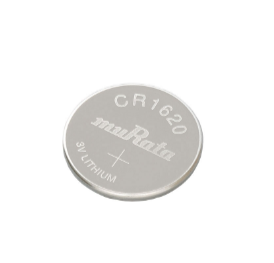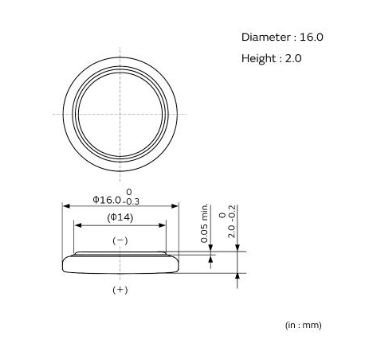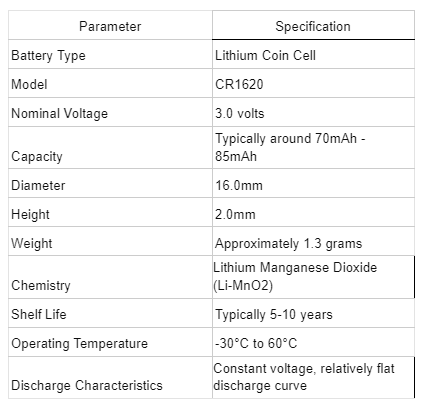3月 08, 2024
3658

The CR1620 is a type of lithium button cell battery. It is a small, circular battery that is commonly used in various electronic devices such as watches, calculators, key fobs, hearing aids, laser pointers, and some medical devices.


Overall, the CR1620 battery's combination of compact size, reliable voltage, and low self-discharge rate makes it an ideal power source for a wide range of devices, including watches, calculators, remote controls, and small electronic gadgets.
Compact Size: With dimensions of 16.0 x 2.0 mm (~0.62992 x 0.78740 inches), the CR1620 is incredibly compact, making it suitable for small devices where space is limited.
Nominal Voltage: The battery operates at a nominal voltage of 3.0 volts, providing reliable power to compatible devices.
Cutoff Voltage: The cutoff voltage of 2.0 volts ensures that the battery is not over-discharged, which helps prolong its lifespan.
Nominal Capacity: The nominal capacity typically ranges between 65-80 mAh, although this can vary based on factors such as battery age, discharge rate, and operating conditions.
Discharge Rate: The standard discharge rate of around 0.1 mA with a maximum discharge rate of approximately 1.0 mA ensures a steady power supply to the device. However, it's essential to note that higher discharge rates can reduce the effective capacity of the battery.
Chemistry: The CR1620 battery is a non-rechargeable manganese-dioxide lithium battery, offering a stable power source for devices.
Self-Discharge Rate: Most CR1620 models feature a low self-discharge rate at room temperature, typically around 1-2% per year. Premium models may offer even lower self-discharge rates, making them suitable for applications where long-term reliability is essential. However, it's crucial to note that higher temperatures can increase the self-discharge rate, potentially reducing the battery's shelf life.
Compatibility: The CR1620 battery is known by various labels, including CR1620 (IEC standard) and 5009L (ANSI standard). Other labels such as ECR1620, DL1620, and VCR1620 may also be used, depending on the manufacturer.
The CR1620 battery is manufactured by various companies around the world. Some of the prominent manufacturers of CR1620 batteries include:
Panasonic Corporation: Panasonic is a well-known electronics company that produces a wide range of batteries, including lithium button cell batteries like the CR1620.
Sony Corporation: Sony is another major player in the electronics industry, manufacturing batteries for various applications, including CR1620 lithium button cells.
Maxell Corporation: Maxell is a Japanese company known for its electronic products, including batteries. They produce CR1620 batteries among other types.
Energizer Holdings, Inc.: Energizer is a globally recognized brand in the battery industry. They manufacture CR1620 batteries along with other types of batteries for consumer electronics.
Duracell Inc.: Duracell is another well-known brand in the battery market. They produce CR1620 batteries as part of their extensive product lineup.
These are just a few examples of manufacturers producing CR1620 batteries. There are also other companies globally producing these batteries to meet the demand for various electronic devices. When purchasing CR1620 batteries, it's essential to ensure they come from reputable manufacturers to guarantee quality and performance.
The CR1620 is a common type of lithium button cell battery. Here are some equivalent batteries that can be used in place of a CR1620:
CR1620 (most common)
DL1620
ECR1620
BR1620
L1620
280-208
DL1620B
BR1620-1W
CR1620-1W
KCR1620
LM1620
5009LC
These equivalent batteries all have the same voltage (3V) and diameter (16mm), but they may have slightly different thicknesses. It is important to check the space available for the battery in your device before choosing a replacement.
Here are some additional things to keep in mind when choosing a CR1620 equivalent battery:
Capacity: The capacity of a battery is the amount of charge that it can store. Batteries with higher capacities will last longer than batteries with lower capacities.
Brand: There are many different brands of CR1620 equivalent batteries available. All brands should meet the same safety and performance standards, but there may be some variation in quality.
Price: CR1620 equivalent batteries can vary in price. It is important to shop around to find the best deal.
CR1620 batteries are versatile power sources due to their small size, long shelf life, and ability to deliver constant voltage. They are commonly used in a wide variety of consumer electronics.
Watches and Calculators: These are classic applications for CR1620 batteries due to their ability to provide steady power in a small form factor.
Key Fobs and Remote Controls: The low-drain current required by key fobs and remote controls makes CR1620 batteries a perfect fit for these devices.
Hearing Aids: Many hearing aids rely on CR1620 batteries for extended operation.
Medical Devices: Certain medical devices, such as glucose monitors and blood pressure cuffs, utilize CR1620 batteries due to their compact size and reliable performance.
Laser Pointers: The concentrated beam of a laser pointer requires a steady power source, which a CR1620 battery can provide.
Memory Backup in Computers: Some computer motherboards incorporate a CR1620 battery to maintain BIOS settings when the computer is unplugged.
Other Electronic Devices: CR1620 batteries are found in various other electronic devices due to their versatility, including thermometers, garage door openers, and pedometers.
The ML1620 battery is indeed an equivalent rechargeable alternative to the non-rechargeable CR1620 battery. Here's a comparison between the two:
Type:
CR1620: Non-rechargeable lithium manganese-dioxide battery
ML1620: Rechargeable lithium manganese-dioxide battery
Nominal Voltage:
Both CR1620 and ML1620 have a nominal voltage of 3.0 volts.
Capacity:
CR1620: Typically around 65-80 mAh (nominal capacity)
ML1620: Capacities may vary, but generally similar to or slightly higher than CR1620
Rechargeability:
CR1620: Non-rechargeable; meant for single-use applications
ML1620: Rechargeable; can be recharged multiple times using appropriate charging equipment
While the ML1620 can replace the CR1620 in many applications, it's important to note that the ML1620's physical dimensions may not be identical to the CR1620. Therefore, compatibility with the device's battery compartment size should be verified before substitution. Additionally, the ML1620's rechargeable nature may require specific charging equipment and considerations regarding charging cycles and voltage management.
No, a CR1620 battery is not the same as a CR2016 battery. While both are coin cell batteries and share similarities in their naming conventions, they differ in size and thickness:
Size:
CR1620: 16.0 mm in diameter
CR2016: 20.0 mm in diameter
Thickness:
CR1620: 2.0 mm thick
CR2016: 1.6 mm thick
CR1620 is smaller in diameter but thicker compared to the CR2016. Therefore, they are not interchangeable in devices due to differences in physical dimensions. It's essential to use the correct battery size and type as specified by the device manufacturer to ensure proper operation and fit within the battery compartment.
No, a CR1620 battery is not the same as a CR2032 battery. While both are coin cell batteries and share similarities in their naming conventions, they differ in size and thickness:
Size:
CR1620: 16.0 mm in diameter, 2.0 mm thick
CR2032: 20.0 mm in diameter, 3.2 mm thick
Capacity:
CR1620: Typically around 65-80 mAh (nominal capacity)
CR2032: Typically around 200-240 mAh (nominal capacity)
CR2032 is larger in both diameter and thickness compared to the CR1620. Therefore, they are not interchangeable in devices due to differences in physical dimensions. It's essential to use the correct battery size and type as specified by the device manufacturer to ensure proper operation and fit within the battery compartment.
While the CR1632 battery shares similarities with the CR1620 in terms of voltage and appearance, there are important differences in their physical dimensions and capacity:
Size:
CR1620: 16.0 mm in diameter, 2.0 mm thick
CR1632: 16.0 mm in diameter, 3.2 mm thick
Capacity:
CR1620: Typically around 65-80 mAh (nominal capacity)
CR1632: Typically around 120-140 mAh (nominal capacity)
While both batteries have the same diameter, the CR1632 is thicker than the CR1620. Therefore, using a CR1632 instead of a CR1620 may result in fitting issues in devices with tight battery compartments. Additionally, while the CR1632 has a higher capacity compared to the CR1620, it may not provide optimal performance in devices designed specifically for CR1620 batteries.
In some cases, if the device allows for slight variations in battery size and has sufficient space to accommodate the thicker CR1632, it might work as a temporary replacement. However, it's always recommended to use the correct battery size and type as specified by the device manufacturer to ensure proper operation and avoid potential damage or malfunction.
CR2016 and CR2032 batteries are not interchangeable due to several reasons:
Physical Size Differences: CR2016 batteries are thinner (1.6 mm) than CR2032 batteries (3.2 mm), despite having the same diameter (20 mm). This difference in thickness may prevent proper fitting or cause damage to the device if the wrong size is used.
Voltage Differences: CR2016 batteries typically have a nominal voltage of 3 volts, just like CR2032 batteries. However, if you stack up two CR2016 batteries to replace a CR2032, you would indeed have a total voltage of 6 volts, which is double the voltage required for the device. This can lead to damage or malfunction of the device's electronics.
Designated Usage: Manufacturers designate specific battery models for different devices based on their voltage, capacity, and size requirements. Using a different battery model than what is specified by the manufacturer can compromise the device's performance, lifespan, and safety.
Therefore, it's essential to use the correct battery size and type as specified by the device manufacturer to ensure proper operation and avoid potential damage or safety hazards.
While it's true that CR2032 batteries have a higher capacity than CR2016 batteries and may fit into some devices despite being thicker, it's important to exercise caution when substituting one battery type for another.
Physical Fit: Although CR2032 batteries are thicker than CR2016 batteries, some devices may still accommodate the larger size. However, it's essential to ensure that the thicker battery fits securely within the battery compartment without causing any damage to the device.
Voltage Compatibility: Both CR2016 and CR2032 batteries typically have a nominal voltage of 3 volts. However, as previously mentioned, stacking two CR2016 batteries to replace a CR2032 would result in a total voltage of 6 volts, which could damage the device. Therefore, if a CR2032 fits and is used as a replacement for a CR2016, it should provide the correct voltage without any issues.
Longevity: Due to its higher capacity, a CR2032 battery may indeed last longer than a CR2016 battery when used in the same device. This can be advantageous in applications where battery life is critical, such as key fobs.
Yes, you can physically replace a CR1616 battery with a CR1620 battery in many cases, as they share the same diameter (16.0 mm). However, it's important to consider the following factors before doing so:
Thickness: CR1620 batteries are thicker (2.0 mm) than CR1616 batteries (1.6 mm). While many devices can accommodate the slightly thicker battery, it's essential to ensure that the CR1620 fits securely within the battery compartment without causing any damage to the device.
Capacity: CR1620 batteries typically have a higher capacity than CR1616 batteries. Replacing a CR1616 with a CR1620 may result in longer battery life in some cases. However, it's important to note that using a battery with a higher capacity does not necessarily guarantee better performance if the device's electronics are not designed to take advantage of the extra capacity.
Maximum Drain/Pulse Currents: CR1620 batteries may have slightly higher maximum drain/pulse currents compared to CR1616 batteries. While this may not be a significant issue for many devices, it's essential to consider whether the device's specifications and requirements align with the capabilities of the CR1620 battery.
The cutoff voltage for a CR1620 battery is typically 2.0 volts. This cutoff voltage is considered the minimum allowable voltage, below which the battery is considered depleted or empty.
While the nominal voltage of a CR1620 battery is 3.0 volts, its voltage decreases gradually as it discharges. When the battery's voltage reaches or drops below the cutoff voltage of 2.0 volts, it is no longer able to provide sufficient power for most devices and is considered to have reached the end of its usable life.
Size:
Both CR1616 and CR1620 batteries have the same diameter of 16mm, denoted by the first two digits of their names.
The difference lies in their thickness: CR1616 batteries are 1.6mm thick, while CR1620 batteries are 2.0mm thick. The last two digits represent the thickness in tenths of millimeters.
Compatibility:
While CR1616 and CR1620 batteries have the same diameter, their difference in thickness can impact compatibility.
CR1620 batteries may not fit properly in devices designed for CR1616 batteries. Attempting to use a thicker battery may result in the battery compartment lid not closing securely or the battery contacts being distorted, which could affect the device's functionality.
Capacity:
Generally, CR1620 batteries have a higher capacity compared to CR1616 batteries due to their larger size. This means CR1620 batteries may last longer in devices with similar power requirements.
About ten years.